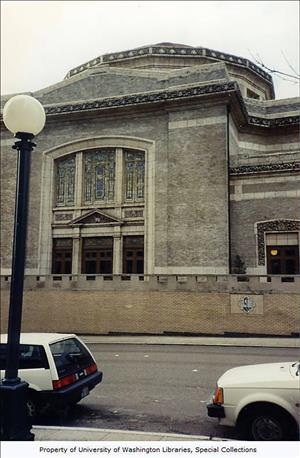On May 9, 1996, the Washington State Supreme Court, in a 5 to 4 decision, denies the Seattle Landmarks Board its designation of the First United Methodist Church as a landmark. The church, occupied by the oldest Christian congregation in Seattle, is located downtown on the west side of 5th Avenue between Marion and Columbia streets (811 5th Avenue). The church was spared demolition through a special deal reached with developer Nitze-Stagen reached on May 20, 2007.
James Schack and Daniel Huntington, well known early twentieth-century Seattle architects, designed the 5th Avenue sanctuary, then called the First Methodist Episcopal Church. Construction began in 1907 and enough of the church was complete to hold sermons in it the following year. The Beaux Arts style sanctuary, with its 66-foot high interior ceiling, brick and terra cotta façade, and orange tile-covered central dome was completed and dedicated in 1910.
Genealogy of a Historic Building
The 5th Avenue building was the Methodists' third building. The congregation descends directly from that of the "White Church," built by the Reverend David Blaine (1824-1900) in 1855. Blaine, Seattle’s first resident pastor, arrived just 18 months after the town’s first log cabins were completed. On December 4, 1853, Reverend Blaine delivered his first two sermons at New York (later called Alki, today part of West Seattle) and then paddled across Elliott Bay to Seattle and organized a church composed of four members.
A few months later, Carson Boren (1824?-1912) donated land at the southeast corner of 2nd Avenue and Columbia Street and on May 19, 1855, Reverend Blaine held dedication ceremonies at Seattle’s first church. The later-named White Church measured 24 x 36 feet and had 14-foot high ceilings and enough room for 150 parishioners.
For 10 years the Methodist Episcopal Church (painted white) was Seattle's only church. In 1865, to prevent confusion with the town's second church, the Methodist Protestant Church (painted brown), the Methodist Episcopal Church was given the appellation the "White Church."
By the mid-1880s, the congregation outgrew the White Church. In 1884, the White Church had 269 members and probationers and continued to grow with Seattle’s burgeoning population. The congregation acquired land at 3rd Avenue and Marion Street and from 1887 to 1889 constructed a gothic style church.
The new church was dedicated on September 15, 1889. Church membership quickly grew. By 1890 the congregation had increased to 495 members and probationers. The gothic style edifice stood for just 18 years: It attained a bit more than half the age of the church’s first building. During its era, the city grew in population about eight times, from about 25,000 persons to about 200,000.
Although church membership continued to increase (in 1903 it comprised 1,155 members and probationers), and although the street came to be dominated by business and commercial use, the church was forced to move by the 1906-1907 regrading of 3rd Avenue. The regrade lowered the street at least one story. The First Methodist Church used the proceeds of the sale of the 3rd Avenue property to purchase the 5th Avenue site and begin construction. During 1906 and 1907 church services were held first in a tent and then in a theater.
The congregation increased from 1,700 parishioners in 1910 when the church was dedicated, to 3,756 parishioners by 1938. In 1968, the church’s name changed to First United Methodist Church.
Church v. State
In February 1985, the Seattle Landmarks Preservation Board approved the nomination of the Seattle First United Methodist Church for landmark designation. After losing an appeal before the Seattle Hearing Examiner, the church sued in Superior Court to void the designation.
The case was appealed through the state courts and was heard before the Washington State Supreme Court on September 27, 1995. On May 9, 1996, the Court ruled that, due to the restrictions it placed on the use of the church building, the landmark designation was unconstitutional because it violated the First United Methodist Church's right to free exercise of religion.
In May 2002, it was revealed that the Church had retained the Seneca Group to help it plan redevelopment of its downtown property, including demolition of the historic sanctuary. Developer Martin Selig offered the congregation an alternative property in Belltown for the right to build a high-rise tower on the site. Spurred by Heather MacIntosh, preservation advocate for Historic Seattle, and other preservationists, City and County officials -- notably Mayor Greg Nickels (b. 1955) and County Councilmember Dow Constantine (b. 1961) -- sought to broker alternative deals to spare the sanctuary. After much negotiation, on May 20, 2007, the congregation voted unanimously to accept a proposal from Kevin Daniels, president of Nitze-Stagen (developers of the giant Sears building as Starbucks' corporate headquarters), which saved the historic sanctuary and relocated the curch community to a new site.

